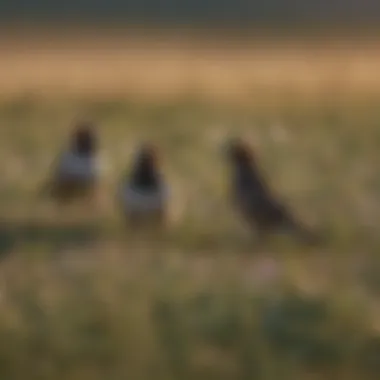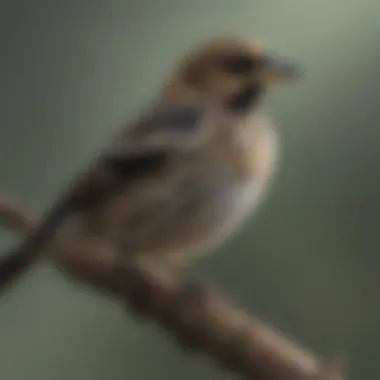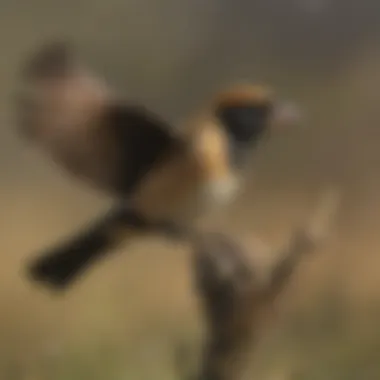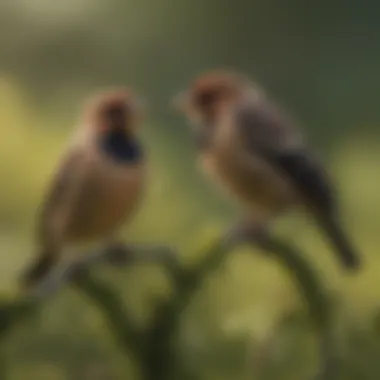Unraveling the Mysteries of the Bobolink: A Complete Exploration


Overview of the Topic
Through this comprehensive guide, we embark on a journey to discover the enigmatic bobolink, a bird renowned for its intriguing breeding habits and melodious songs. This exploration is designed to illuminate the various aspects of the bobolink’s life, from its unique physical characteristics to its intricate migration patterns.
Current State and Challenges
Delving into the present scenario, we evaluate the current status of the bobolink population and the challenges it faces in its natural habitat. By closely examining the environmental factors impacting these birds, we gain insight into the threats that pose risks to their existence.
Sustainable Solutions
In the quest for viable solutions, we explore sustainable practices that can mitigate the challenges encountered by bobolinks. By showcasing successful case studies and effective resource management strategies, we aim to inspire conservation efforts and promote responsible stewardship of natural resources.
Impact and Importance
Analyzing the ripple effects of the bobolink’s presence on ecosystems and communities, we underscore the significance of conservation initiatives. Through an in-depth investigation, we highlight the crucial role of sustainable resource use in safeguarding not only bobolinks but also the environment for future generations.
Introduction to the Bobolink
The section on 'Introduction to the Bobolink' serves as the cornerstone of our comprehensive guide. This segment is crucial in providing readers with a foundational understanding of the charismatic bird species, setting the stage for an in-depth exploration of various aspects related to the bobolink. By delving into the history, characteristics, and significance of the bobolink, readers can gain a profound appreciation for this enigmatic avian species.
Overview of the Bobolink Species
Physical Attributes
When we delve into the physical attributes of the bobolink species, we uncover a myriad of fascinating features that contribute to its uniqueness. From its striking black and white plumage to the distinctive straw-colored nape on the male bobolink, each physical characteristic plays a vital role in the bird's adaptation and survival in its habitat. The sleek and compact body shape of the bobolink enables agile flight maneuvers, essential for foraging and evading predators. Despite the visual appeal of its plumage, the bobolink's coloration also serves a functional purpose by providing camouflage in its grassland habitats.
Habitat Preferences
Exploring the habitat preferences of the bobolink sheds light on the intricate relationship between this avian species and its surroundings. Bobolinks exhibit a strong affinity for open grasslands and meadows with dense vegetation, where they can build their nests and forage for food. These habitat preferences are crucial for the bobolink's breeding success and overall population health. By understanding the specific requirements of the bobolink's habitats, conservation efforts can be tailored to preserve these critical ecosystems and ensure the continued existence of the species.


Historical Significance
Cultural Representations
The historical significance of the bobolink extends beyond its biological traits, encompassing cultural representations that have shaped human perceptions of this avian species. In literature and folklore, the bobolink is often portrayed as a symbol of freedom and creativity, celebrated for its melodic songs and graceful flight. These cultural representations highlight the emotional and symbolic connection that humans have forged with the bobolink over centuries, adding richness to the tapestry of human-bird interactions.
Conservation Status
Delving into the conservation status of the bobolink reveals the urgent need to protect this charismatic bird from various threats. The bobolink faces challenges such as habitat loss due to agricultural intensification and climate change impacts that disrupt its migratory patterns. Understanding the conservation status of the bobolink is paramount in formulating effective strategies to safeguard its future existence and ensure the preservation of this cherished avian species.
Migration Patterns of the Bobolink
Exploring the Enigmatic Bobolink delves into the nuanced topic of Migration Patterns of the Bobolink, offering readers a profound understanding of the bird's migratory behaviors. The migration patterns play a pivotal role in the life of the bobolink, impacting its survival and ecosystem dynamics. Understanding these patterns is crucial for conservation efforts and ecosystem management.
Annual Migration Routes
North America to South America Journey
The North America to South America Journey stands out as a key aspect of the bobolink's migration, covering vast distances with remarkable precision. This journey is essential for the bird's survival, ensuring access to suitable breeding grounds and resources. The bobolink's ability to navigate this extensive route showcases its innate orientation skills and adaptability to diverse environments, rendering this migration path significant in the study of avian ecology.
Factors Influencing Migration
Factors Influencing Migration encompass a multitude of environmental cues and internal mechanisms that drive the bobolink's migratory behavior. From changing seasonal patterns to genetic predispositions, these factors intricately shape the timing and duration of migration. Exploring these influences provides invaluable insights into the bird's responses to environmental changes and human disruptions, guiding conservation strategies and habitat preservation efforts.
Conservation Challenges
Habitat Loss
Habitat Loss presents a formidable challenge to the bobolink population, jeopardizing vital nesting sites and foraging grounds. The encroachment of human developments and agricultural practices poses a direct threat to the bird's habitat, leading to population declines. Mitigating habitat loss requires collaborative efforts in land conservation and sustainable land use practices to safeguard critical areas for the bobolink's survival.


Climate Change Impact
Climate Change Impact amplifies the conservation challenges faced by the bobolink, disrupting traditional migration patterns and altering ecosystems. The increasing unpredictability of weather patterns and habitat degradation due to climate change pose significant risks to the bird's long-term survival. Addressing these impacts necessitates proactive measures to mitigate carbon emissions, enhance habitat resilience, and promote adaptive conservation strategies.
Behavioral Traits of the Bobolink
When delving into the comprehensive guide of 'Exploring the Enigmatic Bobolink,' understanding the behavioral traits of this avian species is paramount. The behavioral traits encompass a range of intricate patterns that dictate the bobolink's interactions within its ecosystem. It is crucial to analyze these behaviors to grasp the species' dynamics fully.
Feeding Habits
Dietary Preferences
Examining the dietary preferences of the bobolink sheds light on its foraging habits and nutritional needs. The species' dietary choices play a vital role in its survival and reproductive success. By focusing on dietary preferences, we can unravel the intricate connection between food availability and the bobolink's overall health.
Foraging Techniques
The foraging techniques employed by the bobolink are crucial for its sustenance in various habitats. From ground foraging to aerial maneuvers, understanding these techniques offers insights into the bird's adaptability and resourcefulness. Exploring the unique foraging strategies emphasizes the bobolink's evolutionary prowess and successful foraging methods.
Social Interactions
Diving into the social interactions of the bobolink reveals intricate dynamics within its communal structures. Group dynamics among bobolinks showcase collaborative behaviors that aid in foraging, predator detection, and mate selection. Understanding these social dynamics enhances our appreciation for the species' cooperative nature.
Group Dynamics
The group dynamics of bobolinks provide a window into their social organization and cooperative strategies. Interactions within bobolink groups offer protection against predators, optimize foraging efficiency, and facilitate knowledge transfer among individuals. Exploring these group dynamics illuminates the species' social complexity and mutualistic tendencies.
Communication Strategies
Communication among bobolinks encompasses a diverse range of vocalizations and visual displays that contribute to intra-group cohesion and reproductive success. By dissecting these communication strategies, we decipher the language of bobolinks and uncover the nuanced cues that govern their interactions. Examining the unique features of their communication further highlights the significance of vocal and visual signaling in the species' survival.


Bobolink's Role in Ecosystem
The section on Bobolink's Role in Ecosystem aims to delve into the intricate interactions between this charismatic bird species and its environment. Bobolinks play a crucial role in seed dispersal, which significantly impacts plant diversity within their habitats. By consuming a variety of seeds during foraging, bobolinks unintentionally aid in plant propagation, contributing to the overall biodiversity of the ecosystem. Their foraging habits and migration patterns play a vital role in maintaining a balanced ecosystem.
Seed Dispersal
Impact on Plant Diversity
Understanding the Impact on Plant Diversity is essential to grasp the significance of bobolinks in ecosystem dynamics. Bobolinks contribute to the dispersion of seeds from various plant species, promoting genetic variation and ecological resilience. This process enriches plant communities and sustains habitats by ensuring the survival of diverse plant species. The unique foraging behavior of bobolinks results in a widespread distribution of seeds, thereby influencing the composition and structure of plant populations.
Ecosystem Services
Exploring the Ecosystem Services provided by bobolinks sheds light on their broader environmental contributions. Apart from seed dispersal, bobolinks offer pest control benefits by consuming insects harmful to plants. This natural pest management reduces the need for chemical interventions, promoting a healthy and sustainable ecosystem. Additionally, the presence of bobolinks in agricultural landscapes can enhance soil health through their foraging activities, showcasing the multi-faceted benefits these birds provide.
Predator-Prey Relationships
Defense Mechanisms
Examining the Defense Mechanisms employed by bobolinks reveals their evolutionary adaptations for survival. Bobolinks exhibit camouflage tactics to evade predators, blending seamlessly with their grassland habitats. Their cryptic coloration and behavior help them avoid detection, ensuring their safety while nesting and foraging. By understanding these defense strategies, conservation efforts can be tailored to preserve these mechanisms and enhance bobolink populations.
Predation Patterns
Analyzing Predation Patterns involving bobolinks unveils the complexities of their interactions within the ecosystem. These birds face threats from various predators, ranging from ground-dwelling mammals to aerial hunters. Studying predation patterns helps researchers assess the impact of predation on bobolink populations and implement effective conservation measures. By unraveling these intricate relationships, conservationists can develop strategies to mitigate predator pressures and safeguard bobolink communities.
Conservation Efforts and Future Outlook
Conservation Initiatives - Protected Areas
In discussing the segment on Protected Areas within the Conservation Initiatives section, the focus is primarily on designated zones that serve as sanctuaries for species like the bobolink. These areas are pivotal in safeguarding the natural habitat of the bird, offering a safe haven for breeding, foraging, and overall sustenance. The key characteristic of Protected Areas lies in their ability to provide undisturbed environments, free from human interference, essential for the bobolink's well-being. Their conservation value is evident in maintaining biodiversity and ecological balance, making them a favorable choice for addressing the conservation challenges faced by the bobolink species.
Conservation Initiatives - Community Engagement
Exploring the domain of Community Engagement within the Conservation Initiatives section elucidates the significance of involving local communities in conservation efforts. This aspect emphasizes the crucial role that communities play in advocating for the protection of bobolinks and their habitats. By fostering a sense of stewardship and environmental responsibility among residents, Community Engagement becomes a powerful tool in raising awareness and promoting sustainable practices. The unique feature of Community Engagement lies in its ability to bridge the gap between conservation goals and community interests, fostering a sense of ownership and collective action. While it presents challenges in terms of varied perspectives and conflicting priorities, its advantages in promoting long-term conservation far outweigh any potential disadvantages.
Research Directions
Within the ambit of Research Directions, a detailed exploration of Technological Advancements and Ecological Studies is indispensable for enhancing our understanding of bobolinks and their ecosystem. The focus on Technological Advancements highlights the role of innovation in conservation biology, showcasing how cutting-edge tools and methods are revolutionizing research and monitoring efforts. By leveraging technology, researchers can gather precise data on bobolink behaviors, movements, and population trends, facilitating informed decision-making for conservation strategies. As for Ecological Studies, the emphasis is on scientific investigations into the intricate relationships between bobolinks, their environment, and other species. Through rigorous fieldwork and analysis, ecologists unravel the complexities of the bobolink's ecological niche, elucidating the species' significance in the broader ecosystem. While each approach presents its distinct advantages and challenges, their combined contributions pave the way for a comprehensive understanding of the bobolink and illuminate paths for future conservation endeavors.



